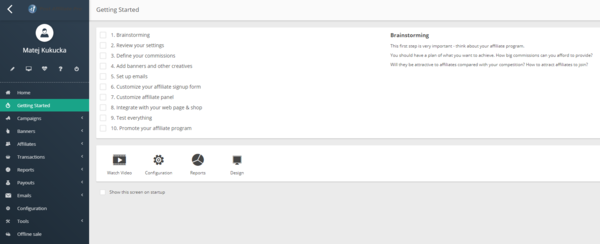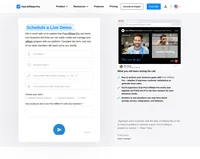Having an affiliate onboarding process is the first step towards building a positive relationship between you and your affiliates. What should you know about onboarding? Read on to find out!
You’ve started your affiliate program and gathered people who will work as your new affiliates. What’s next? Onboarding them. Onboarding allows new employees to get acquainted with and introduced to the hiring company and its goals while obtaining all the information they need to commence their work and start to build a positive relationship with the employer.
This takes some stress off the new employees’ shoulders and allows them to become more productive as they will know how they fit into the company and what is expected of them. Onboarding is also incredibly important when it comes to the overall success of your affiliate program.
What is affiliate onboarding?
Affiliate onboarding is the process of getting your new hires familiar with your affiliate program, goals, and expectations so that they’re ready to start promoting your products. Usually, an onboarding program includes:
- An introduction to your products
- Providing access to any tools the affiliate might need and training them to use them
- An explanation of your company’s rules and procedures
- An introduction to their new coworkers
- Assigning a mentor or manager to whom they can reach out to with any problems or questions.
The affiliate onboarding process won’t be complete in just a day or two – among HR professionals, the general opinion is that onboarding should take at least three months. During this time, you should check on the new employees often, give them regular feedback on their progress, and ask whether they have any concerns or questions.
SilkRoad Technology reports that 53% of HR professionals say that the onboarding process boosts employee engagement.
On the other hand, employees who experienced poor onboarding or had none at all are often disengaged and twice as likely to leave the company. So how can you make sure this doesn’t happen with your new hires? Here are five strategies for successfully onboarding your new affiliates.
Five proven strategies for affiliate onboarding
1. Have a “Getting Started” guide ready for your new affiliates
Your new affiliates are likely to have plenty of questions regarding their responsibilities, company rules, and the affiliate tools they will be using. To help them get started and avoid having to repeatedly explain the same things, a good idea would be to prepare a guide for affiliates with all the information they might need during onboarding.
This guide should include information about the company’s mission and the products they will be promoting, as well as answers to questions like “What are the company guidelines for creating content?”, “How do I create links?”, or “What are the rules for earning commissions?”

A guide is also a great place to provide a short tutorial on how to use their affiliate tools and who to contact if they have a problem. Having a guide makes your new hires more confident and makes the affiliate onboarding process smoother, but it also means they don’t have to contact you with every question or problem they might have.
Be careful not to overwhelm your new affiliates with too much information and technical jargon when preparing a guide, as your new affiliates might not be able to understand industry-specific terms. Sticking to the simple language will ensure that all your new hires understand the instructions and know what is expected from them.
2. Explain all details of the program to affiliates clearly
While you can’t completely avoid misunderstandings when onboarding your affiliates, explaining all the crucial details and requirements will help prevent most misunderstandings from getting in the way of their productivity. Key points your affiliates should know at the start are:
- Commission rates and when they are paid out
- Terms of the program and your company policy
- The affiliate’s primary responsibilities and duties
- Payout time and methods
- Work incentives, bonuses, and how they can be earned
- Who to contact with questions and problems
Besides explaining these things to your affiliates during your first meeting, we also recommend adding the answers to these questions to the aforementioned Getting Started guide.
3. Set up channels for regular communication
Although guides are very helpful, even the best ones won’t cover all questions or problems your affiliates might have. Whether you hire a manager to take care of affiliates or oversee them yourself, it’s crucial that they know who they should reach out to and on what channel in case any questions or issues arise. Providing a dedicated email address through which affiliates will be sent all relevant materials is one option, but a team chat would be far more convenient for daily communication and also help with building a community between affiliates.
It’s also worth thinking about hosting a regular team meeting and scheduling face-to-face appointments through video conferencing to discuss any needs or problems your affiliates might have and give them feedback on their performance.
4. Provide affiliates with various marketing materials
While your new affiliates might know how to make content for their given audience, they will need material from you for promoting your products or services. Having company-branded materials available for affiliates right at the start helps in two ways. Firstly, they allow affiliates to start promoting the products right away. Secondly, promotional content with your company’s logo, colors, font, or brand images will be easily recognizable, which builds consistency among the affiliates’ followers.

As for the materials you can provide affiliates with, you have many options – from banners and images, through YouTube videos or social media posts, to special discounts. You can use Post Affiliate Pro to share promotional materials with affiliates more efficiently, as it offers a vast amount of content immediately ready for use – from flash, image, and HTML banners, through discount codes, to personalized websites for each affiliate.
5. Personalize the affiliate onboarding process
Your new affiliates might come from various places and have different levels of experience – one might be a blogger who has already worked as an affiliate marketer, while another could be an existing customer who knows next to nothing about affiliation. Going through the same scripted onboarding process with them both might not produce the best results.
The newbie might have problems understanding the basics of affiliation (such as how to start promoting a product) and need more training on how to use various tools, while the blogger may need to receive promotional content only and can handle the rest themself.
And while the blogger might have no problems with starting their work straight away, putting too many responsibilities on an inexperienced affiliate’s shoulders may be simply overwhelming and cause them to leave the program. Creating a customized affiliate onboarding that takes the skills, abilities, and needs of each affiliate into consideration builds confidence and engagement of new hires while helping them settle into their new responsibilities. In order to adjust the affiliate onboarding program to each new hire, think about the answers to these questions:
- What are the affiliate’s main skills?
- What are their strengths and weaknesses?
- What is their working pace?
- What would help them get comfortable with their responsibilities?
- What type of training do they prefer?
- How often do they need to be checked on/have a 1-on-1 meeting?
- What tools/information do they currently need most?
- What incentives work best for them?
When a new hire feels they are valued as an individual, and the program is personally tailored to their needs by giving them all the information and tools they need straight away, it helps them become productive faster. Plus, their trust in the company and their confidence in the job will grow, which can boost their job satisfaction as well.
To wrap up
Onboarding is often overlooked completely or companies only scratch at the surface so they can get new hires down to work faster. But the results are often worse than expected, as new employees take more time to produce results without a good onboarding program.
Onboarding is the key to success for performance-based affiliate marketing. If new affiliates feel valued and welcomed into the program and are given all the tools they need to start working comfortably at their own pace, their engagement and satisfaction in the long-term will increase. Once their onboarding is successfully over, achieving affiliate marketing success will be a piece of cake for them.
Share this article
9 affiliate marketing tools that’ll help you run your affiliate program
Discover 9 essential tools to supercharge your affiliate marketing program! From visual content creation with Visme to comprehensive management with Post Affiliate Pro and audience insights via Smartlook, these tools will boost your sales and refine your strategy. Dive in to maximize your affiliate success!
Affiliate marketing email templates
Discover expertly crafted email templates for affiliate marketing with Post Affiliate Pro. Enhance your communication by motivating, acknowledging, and engaging affiliates effectively. From terms and conditions to product launches, these templates ensure clear and consistent messaging to boost your affiliate program's success. Visit now to streamline your affiliate communication!
How To Find Affiliates to Sell Your Products
Discover over 10 successful strategies for finding high-quality affiliates in 2024 to boost your product sales. Learn to leverage influencers, join affiliate networks, and enhance your reach through SEO and social media. Maximize revenue with transparency and ongoing monitoring in your affiliate marketing program.
How to keep your affiliates happy with split commissions
Discover how Post Affiliate Pro's SplitCommission™ feature can boost affiliate motivation and engagement by fairly distributing commissions among all contributors to a sale. Learn how to implement this innovative model to enhance your affiliate program's success.
How to choose affiliate software
Discover how to choose the best affiliate software with Post Affiliate Pro's comprehensive guide. Learn about essential features like tracking, fraud prevention, and customizable commission types, all designed to optimize your affiliate programs. Ensure seamless operations with easy setup, mobile access, and outstanding support to save time and build trust with affiliates. Visit our guide to make informed decisions and boost your affiliate marketing success!












